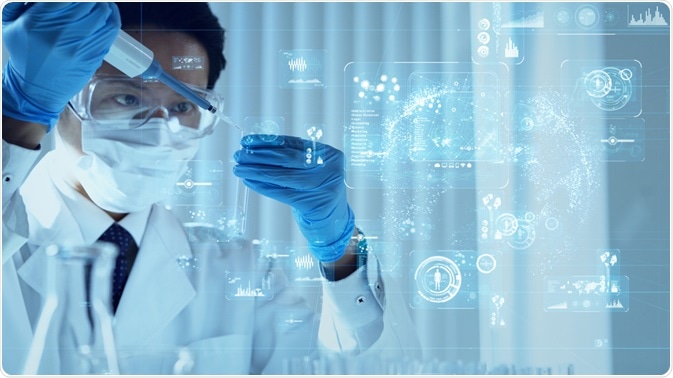Our history is one of constant change, adaptation, and innovation. Innumerable pandemics and epidemics have been caused throughout the centuries by pathogenic microorganisms, and humans have responded by seeking to develop ever-more sophisticated medical treatments. This article will discuss the subject of microbes and drug discovery.

Image Credit: metamorworks/Shutterstock.com
The microbial drug era: Fighting back against killer microbes
The history of medical science stretches back to prehistoric times, but it was not until the modern era that truly effective treatments for the diseases caused by pathogenic microorganisms became a reality.
The microbial drug era began with the discovery of Penicillin by Alexander Fleming. Isolated from the mold Penicillium notatum, this was the first antibiotic. Within a few years of its discovery, Penicillin was being used to treat common bacterial infections. Soon, other naturally occurring antibiotics such as streptomycin and chloramphenicol were isolated and entered the market.
Fast forward to today, and there are hundreds of diverse types of antibiotics on the market that fight many common infections alongside more hard-to-treat ailments. The 6 main groups are the penicillins, cephalosporins, tetracyclines, aminoglycosides, macrolides, and fluoroquinolones. Alongside antibiotics, pharmaceutical scientists have developed numerous antivirals, antifungals, and antiparasitic drugs. Vaccines are deployed worldwide, with arguably the biggest success story being the eradication of smallpox.
Drug resistance: A growing problem
However, success has come at a price. Whilst modern medicine has increased life expectancy by an average of two decades and led to major advancements in organ transplant, cancer therapy, and surgery, the overuse, and misuse of antimicrobial drugs has led to the rise of resistant microbes.
Drug resistance causes massive concerns for healthcare professionals. Healthcare-acquired infections cause millions of deaths worldwide every year and are a bigger cause of death than road accidents. Stronger antimicrobial drugs with more severe side effects are needed to treat even some common infections. This causes additional risks to patient health. This is true of antibiotics, antivirals, antifungals, and antiparasitic drugs.
Not all antibacterial agents show the same resistance development rate. Rifampicin, an antimicrobial agent that targets specific enzymes, shows greater susceptibility to resistance, whereas antimicrobials that target multiple enzymes and other structural and chemical elements in microbes generate irreversible resistance at a slower rate.
Curiously, research has indicated that genes that code for antibiotic resistance in microbes existed long before the discovery of antibiotics. There is a delicate balance between antimicrobial drug development and resistance in microbes. The growth of antimicrobial drug resistance has spurred the development of new, novel antimicrobial drug approaches in recent decades.
Emerging infectious diseases
Aside from resistance, new infectious diseases emerge over time. Notable examples from the past few decades include HIV, SARS, MERS, Ebola, and most recently SARS-CoV-2. Developing therapeutics and vaccines for emerging diseases is of utmost urgency to researchers, governmental bodies, and healthcare professionals worldwide. The re-emergence of tuberculosis since the 1990s has claimed the lives of 35 million people (about twice the population of New York) between 2000 and 2020, according to the WHO.
In the developing world, six diseases and disease processes cause 90% of all deaths from infectious diseases; HIV, tuberculosis, measles, malaria, acute respiratory infections, and diarrhea. Sexually transmitted diseases are on the rise, especially amongst young people aged 15-24. HPV, chlamydia, gonorrhea, and genital herpes all need effective treatments, with some drug-resistant strains of gonorrhea emerging in recent years causing particular concern to sexual health professionals.
Microbes and drug discovery: Recent developments
Many drugs are developed from primary and secondary metabolites of numerous organisms such as plants, animals, and microbes. In 1997, 42% of the best-selling pharmaceutical drugs were derived from microbial metabolites. Hundreds of thousands of microbial secondary metabolites have been identified thus far, providing the building blocks of several clinically important drug treatments. Modern understanding of microbial genetics has led to several revolutions in drug development.
Recent progress in antimicrobial drugs that can treat resistant strains of bacteria is promising. New classes of better antibiotics are being developed. Teicoplanin is a glycopeptide antibiotic that treats infections caused by resistant Gram-positive bacteria, especially those resistant to vancomycin, another commonly used glycopeptide antibiotic.
Another recent development is the drug pristinamycin, a redesign of streptogramin, which can be given at higher doses than oral treatment via other parenteral administration routes. Dalfopristin and quinupristin, the two components of streptogramin, were chemically modified. This new drug was approved by the FDA to treat infections caused by resistant strains of E. faecium. Tetracycline-resistant bacteria can now be treated by recently developed glycylcyclines.
Further developments in antibacterial agents include telithromycin, which is a macrolide antibiotic. This is the first orally active compound in the ketolide antibacterial family. It exhibits potent activity against community-acquired respiratory tract infections.
There has also been progress in the field of antifungals. Fungal infections cause around 40% of all nosocomial infection deaths. Pneumocystis carinii is a major killer of AIDS patients in North America and Europe. Micafungin was approved in 2005 by the FDA for the intravenous treatment of a variety of fungal infections and exhibits potent antifungal activity.
Furthermore, new antiviral treatments have entered the market in recent years. New vaccines based on DNA, RNA, and recombinant proteins, most notably the vaccines approved for use against Coronavirus infections, show huge potential. Novel, targeted therapeutics have been developed from studies on bacterial structure and genetics. Nanotechnology and microbiology have become ever-more intimately associated with numerous research studies using techniques and knowledge from both fields.
The future
The future of microbial drug discovery is replete with challenges. Growth in drug-resistant microbial strains and pandemics caused by emerging infectious diseases are providing impetus for the development of new, novel drugs that will tip the balance in our favor. Research from many associated disciplines such as microbiology, nanotechnology, machine learning, and big data paradigms will all inform the future direction of antimicrobial drug discovery.
References:
Further Reading